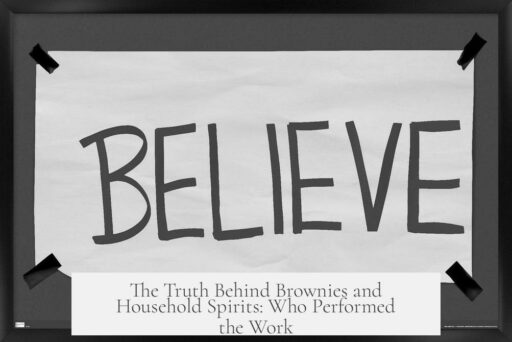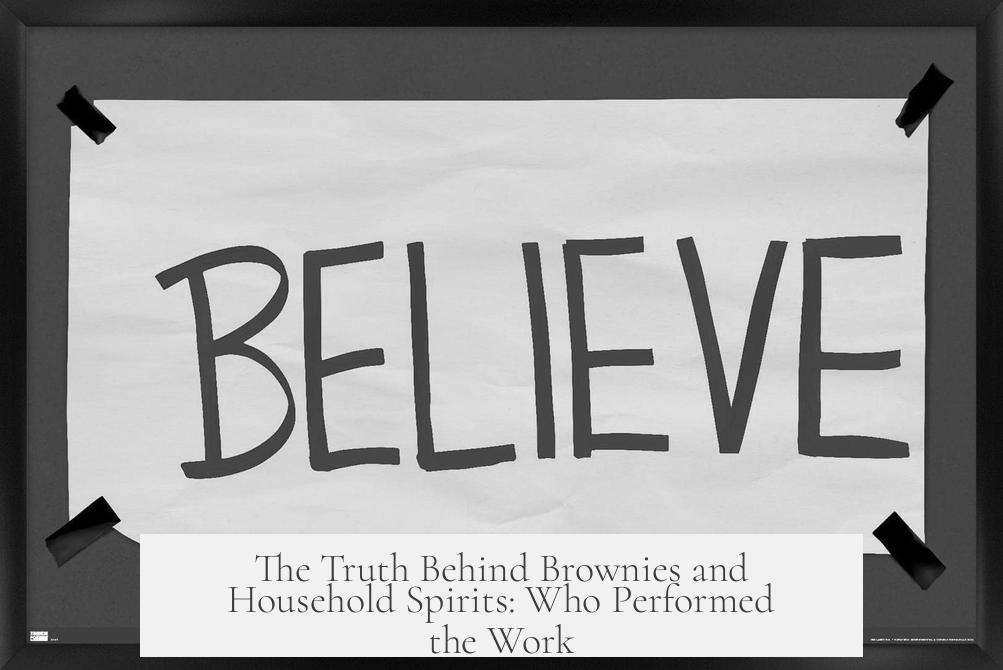Brownies and other household spirits are mythical beings widely believed across Europe to perform labor within homes and barns, especially for kind householders who respect their presence. However, the actual work attributed to these spirits was never directly observed or verified, and it was most likely carried out by humans. The folklore around these creatures served important social and cultural functions, blending superstition with practical everyday life.

The concept of household spirits such as Brownies is common in European folklore. They were considered benevolent but powerful entities residing invisibly in homes or outbuildings. These spirits helped with chores during the night, especially for people deemed good or respectful. In exchange, householders would leave offerings like milk or beer. The spirits demanded respect, as folklore warns of their capricious or even dangerous nature if offended.
Legends surrounding Brownies illustrate their secretive work. A well-known tale, often classified as Migratory Legend ML 7015 or “The New Suit,” tells of a person secretly watching their household spirit at night. Feeling grateful, the person leaves new clothes for the spirit. Once discovered, the spirit puts on the new garments and declares it can no longer work, as the fine clothes must be kept clean. This story emphasizes the spirits’ invisibility and mysterious behavior, reinforcing why their work remained unseen.

Historical and folkloric records reveal no firsthand accounts from farmers, servants, or others who witnessed Brownies at work. Instead, the belief appears to be a cultural narrative explaining why household chores sometimes seemed to get done without direct observation. The actual labor was almost certainly performed by family members, servants, or hired workers. The attribution of chores to supernatural entities likely romanticized and ritualized the labor, making it part of the household’s shared mythology.
This folklore had practical social functions. Respecting the supposed spirits translated into respectful treatment of the home and its inhabitants. Ritual offerings like a bit of milk or beer carried symbolic weight, ensuring no offense would provoke misfortune. Even skeptics would often follow such customs to avoid tempting bad luck. This demonstrates how belief does not require complete conviction—pragmatism and tradition maintain these practices even when their literal truth is questioned.

The Brownies’ presence symbolized unseen forces shaping household productivity. While modern readers might seek rational explanations, folklore inherently resists direct empirical analysis. The stories express cultural values, fears, and social cohesion rather than objective facts. Brownies embody a worldview where unseen powers interact with daily life, making sense to those who practiced these traditions even if they puzzle outsiders today.
| Aspect | Fact or Explanation |
|---|---|
| Who does the labor? | Humans such as family or hired help, not actual spirits. |
| Spirit behavior | Secretive work at night, invisibility; leave offerings to avoid offense. |
| Folklore purpose | Romanticizes labor, adds social cohesion and respect rituals. |
| Historical evidence | No firsthand witness accounts of supernatural labor. |
| Cultural function | Encourages respectful behavior toward household and others. |
Beliefs in Brownies and similar household spirits combine tradition, practical behavior, and folklore to create a compelling cultural explanation for unseen labor. They offer insight into past societies’ ways of organizing work, expressing respect, and coping with mystery in everyday life.

- Brownies symbolize household labor invisibly done but were never actually seen.
- The real work was done by humans, not supernatural beings.
- Folklore encouraged respectful household practices and offerings.
- Belief in spirits reflects cultural values, not empirical reality.
- These legends provided social cohesion and ways to explain the unseen.
What is the Deal with “Brownies” and Other Household Spirits? Who Was Actually Doing the Labor Attributed to These Creatures?
Let’s clear this up from the get-go: the labor credited to “Brownies” and similar household spirits was actually done by regular humans—farmers, servants, family members—but the stories give these unseen workers a magical twist. It’s a classic case of folklore explaining the unexplained, or perhaps just romanticizing hard work.

Brownies, these little mythical helpers, appear across Europe under many names. Everyone from Scotland to Scandinavia had a version of these nocturnal laborers that lived in barns, kitchens, or cottages. They did tasks nobody wanted to do—cleaning, mending, farming chores—all while the household slept. Sounds dreamy, right? But hold on.
The key fact is: no one actually saw these Brownies at work. These spirits are night creatures; their labor is supposedly secret and hidden. Anyone who peeked might scare them away. That touches on the legend known as Migratory Legend ML 7015, or simply “The New Suit.”

The legend tells of a kindly homeowner who left new clothes overnight as a gift for these shabby-dressed Brownies. The next morning, the Brownies donned the new garments and promptly quit their chores—apparently too proud to mess up their fancy clothes. Moral? Beware the gift of clothes or you’ll lose your ghostly workforce!
Of course, this story also hints Brownies are temperamental and must be treated with respect. This capriciousness is central to the folklore. You could benefit from their unpaid labor if you’re decent and don’t spy on them. Otherwise, expect trouble.

But since no farmer, cobbler, or housekeeper ever testified to seeing magical chores happening overnight, who was really lifting baskets or stitching socks? The answer is good old-fashioned human effort, cloaked in myth. Servants, family members, or hired hands quietly put in the work, maybe late at night or early mornings.
Why invent these spirits? Think of it as a cultural safety net and a way to make drudgery less obvious. The belief in Brownies created customs—like leaving out bowls of milk or beer—to ensure these spirits were honored and not angered. Even if belief wobbled, no one wanted to risk offending an unseen but powerful presence in the home or barn.
This social function is fascinating. Even skeptics “knock on wood” or toss a bit of milk just in case. It’s a ritualized respect born from folklore, ease, and a dash of superstition. The spirits serve as a reminder to be humble and polite—to neighbors, guests, and yes, even spectral helpers.
In modern times, these stories might seem like fairy tales or quaint mythology, but they reveal something deep. They offer insight into how people in the past made sense of the world and the unseen efforts that kept households running. The Brownie wasn’t a supernatural labor fairy—Brownies were a cultural way of crediting hard, invisible domestic and agricultural labor.
Think about it: in societies where household help wasn’t always formally recognized, attributing work to household spirits created a charming narrative. It explained why the cottage was clean or the barn was tidy without confronting sweating, exhausted humans behind the scenes.
So, Should We Believe in Brownies?
If you ask folklore scholars, the answer is no—not literally. But belief isn’t always logical. It’s part faith, part cultural practice, and part social glue. The stories offered comfort, rituals, and even a cheeky way to remind everyone they better be kind and respectful—because you never knew who (or what) was watching.
Does this mean we all need to leave out milk for our pets? Probably not. But it might be a fun tradition to keep the spirit alive—pun intended. After all, acknowledging the invisible laborers of the past, whether humans or spirits, makes us appreciate the work done to create a home.
What lessons can today’s busy households take from this? First, invisible labor matters, even when it’s unnoticed or underappreciated. Second, respect and gratitude (even the ritual kind) go a long way in any community—human or otherwise. Third, folkloric stories, even if fanciful, hold clues to our cultural values and social history.
Summary Table: Brownies vs. Reality
| Aspect | Brownies & Household Spirits | Reality |
|---|---|---|
| Nature | Invisible, nocturnal, supernatural helpers | Humans: family, farmers, servants working at night or early |
| Role | Perform secret household tasks magically | Perform actual chores quietly, often without thanks |
| Evidence | Stories, legends, no firsthand sightings | Practical labor done by people, witnessed and required |
| Cultural Purpose | Explain labor, promote respect, and social rituals | Encourage appreciation for hard work and maintain social order |
| Risk | Anger Brownies by spying or ungratefulness | Risk social friction or disrespecting workers |
In the end, “Brownies” and other household spirits are a whimsical lens on labor’s hidden face. They represent how people once coped with the invisible, tiring tasks keeping homes afloat. So next time you clean a room or finish a chore, tip your hat to those real-life “Brownies” in your life—no magical suit required.
Have you ever heard a family legend or mystery about unseen helpers around your house? How do you explain the “magic” in everyday chores? Sharing these stories keeps the spirit alive—no matter what you call it.
What tasks were Brownies and household spirits believed to perform?
They were thought to do chores around the house or barn, like cleaning or repairing things, especially at night. These tasks were seen as favors for kind households that respected the spirits.
Who actually did the work credited to Brownies?
Humans like family members, servants, or hired laborers performed the tasks. The spirits were a folklore explanation to romanticize and make sense of everyday work done quietly or out of sight.
Why did people believe in Brownies if the labor was done by humans?
Belief in these spirits helped maintain social customs. Offering milk or beer and showing respect avoided offending these powerful, unpredictable beings. It was a way to follow tradition and keep peace.
Did anyone ever see Brownies working?
No firsthand accounts exist of people watching household spirits at work. The labor was always described as secret and happening at night, reinforcing the mystery around them.
What cultural purpose did the belief in Brownies serve?
These beliefs encouraged polite and cautious behavior in the home. They kept traditions alive and gave meaning to the unseen efforts that kept households running smoothly, combining faith with everyday life.




